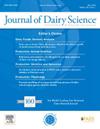Evaluation of treatment with human chorionic gonadotropin at transfer of in vitro–produced beef embryos on reproductive outcomes in lactating multiparous Jersey cows after a synchronized ovulation
IF 3.7
1区 农林科学
Q1 AGRICULTURE, DAIRY & ANIMAL SCIENCE
引用次数: 0
Abstract
Our objective was to evaluate the effect of treatment with human chorionic gonadotropin (hCG) at the time of transfer of in vitro–produced (IVP) beef embryos on pregnancy outcomes in lactating multiparous Jersey cows. Grade 1, stage 7 (expanded blastocyst), IVP beef embryos were produced from black Angus-based dams using 3 proven high-fertility Angus sires and were frozen for direct transfer. In a preliminary experiment, lactating multiparous Jersey cows were randomized to a 2 × 2 factorial arrangement of treatments to test the main effect of recipient synchronization protocol (Double-Ovsynch; DO; n = 169 vs. a synchronized estrus; ED; n = 180) and were randomly assigned within recipient protocol to serve as untreated controls (DO-CON, n = 78; ED-CON, n = 44) or to receive i.m. treatment with 2,500 IU of hCG (DO-hCG, n = 79; ED-hCG, n = 46) at the time of embryo transfer (ET). The recipient utilization rate was greater for DO (93%) than for ED (50%) cows, and an interaction was present between recipient synchronization protocol and hCG treatment in which DO-hCG cows had more pregnancies per ET (P/ET) at 26, 33, and 61 d than DO-CON, ED-hCG, and ED-CON cows. Based on a partial budget analysis, the cost per pregnancy for DO cows was $135.35 less than for ED cows. In experiment 2, lactating multiparous Jersey cows were submitted to a Double-Ovsynch protocol (DO, n = 386) and were randomly assigned to serve as untreated controls (CON, n = 192) or were treated with 2,500 IU hCG (hCG, n = 194) at ET. Progesterone concentrations and total luteal volume 7 d after ET were greater for hCG than for CON cows. In contrast to the preliminary experiment, treatment with hCG did not affect P/ET at 26, 33, or 61 d, and treatment with hCG did not affect pregnancy loss from 26 to 61 d. In conclusion, treatment with 2,500 IU of hCG at ET increased P4 concentrations and total luteal volume 7 d after ET but did not increase pregnancy outcomes or decrease pregnancy loss in lactating multiparous Jersey cows receiving frozen/thawed IVP beef embryos.
对同步排卵后泌乳多胎泽西奶牛在移植体外生产的牛肉胚胎时使用人类绒毛膜促性腺激素对生殖结果的影响进行评估。
我们的目的是评估在移植体外培养(IVP)牛肉胚胎时使用人绒毛膜促性腺激素(hCG)对泌乳多胎泽西牛妊娠结果的影响。1级、7期(扩大囊胚)、IVP牛肉胚胎是用3个经过验证的高繁殖力安格斯种公牛从黑色安格斯母牛身上生产出来的,并冷冻以直接移植。在初步实验中,将泌乳的多胎娟姗牛随机分配到 2x2 因子排列的处理中,以测试受体同步方案的主要影响(双同步发情;DO;n = 169 vs. 同步发情;ED;n = 169 vs. 双同步发情;DO;n = 169 vs. 双同步发情;ED;n = 169 vs. 双同步发情)。ED;n = 180),并在受体方案内随机分配为未经处理的对照组(DO-CON,n = 78;ED-CON,n = 44)或在胚胎移植(ET)时接受 2,500 IU hCG(DO-hCG,n = 79;ED-hCG,n = 46)的静注治疗。DO(93%)奶牛的受体利用率高于ED(50%)奶牛,受体同步方案与hCG治疗之间存在交互作用,其中DO-hCG奶牛在26、33和61 d的每次胚胎移植(P/ET)妊娠数高于DO-CON、ED-hCG和ED-CON奶牛。根据部分预算分析,DO 型奶牛每次怀孕的成本比 ED 型奶牛低 135.35 美元。在实验 2 中,泌乳的多胎娟姗牛接受了双卵同步方案(DO,n = 386),并被随机分配为未经处理的对照组(CON,n = 192)或在ET时接受 2,500 IU hCG(hCG,n = 194)处理。ET 7 天后,hCG 治疗奶牛的孕酮浓度和黄体总容积均高于 CON 治疗奶牛。总之,在ET时注射2500 IU hCG可增加P4浓度和ET后7 d的总黄体量,但不会增加接受冷冻/解冻IVP牛肉胚胎的泌乳多胎娟姗牛的妊娠结局或减少妊娠损失。
本文章由计算机程序翻译,如有差异,请以英文原文为准。
求助全文
约1分钟内获得全文
求助全文
来源期刊

Journal of Dairy Science
农林科学-奶制品与动物科学
CiteScore
7.90
自引率
17.10%
发文量
784
审稿时长
4.2 months
期刊介绍:
The official journal of the American Dairy Science Association®, Journal of Dairy Science® (JDS) is the leading peer-reviewed general dairy research journal in the world. JDS readers represent education, industry, and government agencies in more than 70 countries with interests in biochemistry, breeding, economics, engineering, environment, food science, genetics, microbiology, nutrition, pathology, physiology, processing, public health, quality assurance, and sanitation.
 求助内容:
求助内容: 应助结果提醒方式:
应助结果提醒方式:


